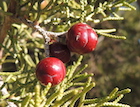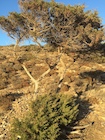Conservation Status

Juniperus turbinata
Guss. 1844
Common names
Mediterranean juniper, العرعر الفينيقي [Arabic], Arbre de l'encens [Catalan], Hrvatska kraška borovica [Croatian], Genévrier turbiné [French], φοινικική άρκευθος [Greek], ערער אדום [Hebrew], Ginepro turbinato [Italian], Sabina-da-praia [Portuguese], sabina negral [Spanish].
Taxonomic notes
Type: Montallegro, Sicily; G. Gasparrini s.n. Historically this was regarded as a variety or subspecies of Juniperus phoenicea, but over time many different lines of evidence have revealed a strong and consistent division between the two taxa, with chemical, molecular, morphological, phenological and ecological differences warranting recognition at species rank (Adams et al. 1996, 2002, 2009, 2013; Arista et al. 1997; Adams 2006; Boratyński et al. 2009; Mazur et al. 2016; see Pavon et al. [2020] for details). The most detailed molecular studies done to date (summarized in Juniperus) show the two species to be, along with Juniperus canariensis, sisters in a highly distinctive clade within Section Sabina. This clade is not particularly closely related to any other junipers. Mazur et al. (2016) estimate that the species diverged within the last two million years, while Mao et al. (2010) estimate the phoenicia-turbinata clade to be more than 30 million years old.
There are 16 synonyms; see POWO for the full list. The only ones you are likely to encounter in contemporary literature are:
- Juniperus phoenicia L. var. turbinata (Guss.) Parl. 1868;
- Juniperus phoenicia L. subsp. turbinata (Guss.) Nyman 1881.
These three species, commonly called the J. phoenicea complex, are a good example of something we've seen a lot of since molecular taxonomy became popular: species that seldom or never hybridize, but that have almost identical morphology. There are minor morphology differences if you know what to look for, but they are subtle compared to the types of differences commonly used to draw a line between different Cupressaceae species. However, they occupy distinct ecological niches, and they have a means of reproductive isolation: flowering at different times of the year.
Description
See Juniperus phoenicea for a description that applies to all three species in the J. phoenicea complex. The following description emphasizes characters that differ between J. turbinata, J. canariensis, and J. phoenicea:
Evergreen shrubs, or trees to 8 m tall. Twig bark reddish. Scale leaves on adult plants 0.7-1 mm long, ovate-rhombic, closely appressed, obtuse, with an oblong furrowed gland and a scarious border; apex not hard/thorny. Pollen shed October-November. Seed cones 7-11 mm diameter, ripening in the 2nd year, turbinate, changing from blackish to green or yellowish, sometimes slightly pruinose; dark red at maturity. Seeds 4-8 per cone, each 4-6 mm long. Compared to J. phoenicea, the leaves are more elongate and more acute, and the seed cones a bit larger, mostly 12-14 mm diameter (Farjon 2010). J. phoenicea cones average 8 seeds, while J. turbinata averages 5-6 seeds (Adams 2014, Mazur et al. 2003, Boratyński et al. 2024).
Distribution and Ecology
Albania; Algeria; Croatia; Cyprus; Egypt; France; Greece; Italy (including Sardinia and Sicily); Jordan; Libya; Malta (introduced and naturalized); Morocco; Portugal; Saudi Arabia; Spain (including the Balearic Islands); Tunisia; Turkey (Adams et al. 2013, Mazur et al. 2016, Pavon et al. 2020). Found at elevations of 0-2450 m; at coastal elevations it appears to be restricted to the hottest of the Mediterranean climates in areas with 400-800 mm annual precipitation, while mountain occurrences are all in the relatively hot/dry region of north Africa in cooler areas that receive about 200 mm annual precipitation (Mazur et al. 2016). Commonly on limestone in the mountains; otherwise on rocky and sandy seashores (Adams 2014), though Pavon et al. (2020) believe "it seems indifferent to the chemical nature of the substrate
although it is more common and abundant on siliceous regions;" they also note that in interior southern Spain it is found on gypsum substrates.
This distribution covers the Mediterranean region and into western parts of the Arabian Peninsula. The species is most abundant in maritime regions of the central and eastern Mediterranean, and in the mountains of the High Atlas in Africa. In the western part of its European distribution, J. turbinata grows mostly on maritime dunes or rocky areas, almost always at <200 m elevation. It is also reported from inland areas on the Iberian Peninsula, including the Extremadura and in the southern Andalusian mountains. The northernmost occurrence is on Krk Island in Croatia (45.2°N). The southern range limit is reached along the shores of the Red Sea at 21°N, with one (unverified) report near Abha, Saudi Arabia (18.5°N). Distributed mainly at low elevations, the highest occurrences are at 2450 m above the road from Tizi n’Illisi to Zouiat Ahanzal, Morocco. The occurrence of the species in parts of the Arabian Peninsula was been reduced due to over-exploitation during the Bronze and Iron Ages, as the wood of juniper was used as a fuel in the copper and iron smelting. Human activities also extirpated J. turbinata from the Negev during the late 6th and 5th millennia BC (Boratyński et al. 2024; see also Pavon et al. [2020] for detailed country-by-country descriptions of distribution).
J. turbinata, like all junipers, relies primarily upon birds to disperse its seeds. In this case, those are mostly birds of the family Turdidae. Locally, other vectors disperse the seeds, including rabbits (Oryctolagus cuniculus) in southern Spain, the black rat (Rattus rattus) in the Hyères archipelago in southeast France, and the red fox (Vulpes vulpes) in Sardinia. In some islands, these introduced mammals likely play a role formerly occupied by indigenous but now extinct native mammals, such as the pika (Prolagus sardus) in Corsica and Sardinia (sources in Pavon et al. 2020). In each case, the vector consumes the ripe seed cones and defecates the seeds, which generally remain viable (Ahlame et al. 2022).
Junipers in general are keystone species for epiphytes and coadapted invertebrates. Such relationships have not been investigated in detail for J. turbinata, but it appears to not be subject to any dwarf mistletoes (Arceuthobium spp.), even when it grows with junipers (J. oxycedrus, J. phoenicea) that are parasitized. It does, however, provide habitat for some rare lichens, including Thelopsis isiaca Stizenb. and Seirophora villosa (Ach.) Frödén. It also likely hosts arthropods that prey upon the cones and seeds, but the subject seems not to have been investigated for J. turbinata (Pavon et al. 2020).
Most investigators have found that this species has relatively low tolerance for fire, which is a frequent disturbance in many Mediterranean vegetation types. J. turbinata appears not to resprout after fire and to be dependent upon regeneration from seed (sources in Pavon et al. 2020).
The IUCN has assessed the conservation status as "Near Threatened" due to habitat loss associated with coastal development (mainly due to tourism), and a small area of occupancy and very high level of population fragmentation, despite the very large area of occurrence (Farjon 2020). Pavon et al. (2020) add overgrazing, logging, invasive vegetation (e.g. Agave spp., Carpobrotus spp.), tree plantations, and climate change to this list of threats, noting that the constellation of threats varies widely across the species' range. For instance, climate change modeling applied to Algeria suggest a reduction in the area of suitable habitat by over 50% by the year 2070 (Arar et al. 2020). Current rangewide rates of decline in J. turbinata are not known, and the species is present in several coastal reserves. Also, the IUCN assessment is somewhat optimistic because it includes Canary Islands populations of Juniperus canariensis. Overall, the conservation status is likely "Vulnerable" at best, and worse if climate change forecasts come to pass.
Remarkable Specimens
No data as of 2023.03.03.
Ethnobotany
I have found no detailed references to use of this species, but it is occasionally mentioned as a source of timber or firewood. Junipers in general are commonly used to flavor meat dishes and, due to their high essential oil content, for varied medicinal purposes.
Observations
I haven't identified any specific locations, but there are several thousand observations of J. turbinata posted on iNaturalist, covering most of the species' range. Most of the posted locations will be accessible to members of the general public.
Remarks
The epithet refers to the turbinate seed cone, i.e. shaped like a spinning top.
Citations
Adams, R. P. 2006. Geographic variation in Juniperus phoenicea from the Canary Islands, Morocco and Spain, based on RAPDs analysis. Phytologia 88(3):270–278.
Adams, R. P. 2014. Junipers of the World, 4th ed. Trafford, Bloomington, IN. 415 p.
Adams, R. P., A. F. Barrero, and A. Lara. 1996. Comparisons of the leaf essential oils of Juniperus phoenicea, J. phoenicea subsp. eu-mediterranea Lehr. & Thiv. and J. phoenicea var. turbinata (Guss.) Parl. Journal of Essential Oil Research 8:367–371.
Adams, R. P., R. N. Pandey, S. Rezzi, and J. Casanova. 2002. Geographic variation in the Random Amplified Polymorphic DNAs (RAPDs) of Juniperus phoenicea, J. p. var. canariensis, J. p. subsp. eu-mediterranea, and J. p. var. turbinata. Biochemical Systematics and Ecology 30(3):223–229.
Adams, R. P., B. Rumeu, M. Nogales, and S. S. Fontinha. 2009. Geographic variation and systematics of Juniperus phoenicea L. from Madeira and the Canary Islands: Analyses of leaf volatile oils. Phytologia 91(1):40–53.
Adams, R. P., A. Boratynski, M. Arista, A. E. Schwarzbach, H. Leschner, Z. Liber, P. Minissale, T. Mataraci, and A. Manolis. 2013. Analysis of Juniperus phoenicea from throughout its range in the Mediterranean using DNA sequence data from nrDNA and petN-psbM: The case for the recognition of J. turbinata Guss. Phytologia 95(2):202-209.
Ahlame, Benabderrahmane, Belhadj Safia, and Daoudi Belkacem. 2022. Juniperus phoenicea’s power of responding to ingestion by potential frugivores in the Central Saharan Atlas (semi-arid)-Algeria. Egyptian Academic Journal of Biological Sciences. C, Physiology and Molecular Biology 14(2):353-365.
Arar, A., Y. Nouidjem, R. Bounar, S. Tabet, and Y. Kouba. 2020. Potential future changes of the geographic range size of Juniperus phoenicea in Algeria based on present and future climate change projections. Contemporary Problems of Ecology 13(4):429-441.
Arista, M., P. L. Ortiz, and S. Talavera. 1997. Reproductive isolation of two sympatric subspecies of Juniperus phoenicea (Cupressaceae) in southern Spain. Plant Systematics and Evolution 208:225–237.
Boratyński, A., A. Lewandowski, K. Boratyńska, J. M. Montserrat, and A. Romo. 2009. High level of genetic differentiation of Juniperus phoenicea (Cupressaceae) in the Mediterranean region: geographic implications. Plant Syst Evol. 277:163–172.
Boratyński, Adam , Montserrat Salvà-Catarineu, Katarzyna Marcysiak, Małgorzata Mazur, Ángel Romo, Pietro Minissale, Kit Tan, Grzegorz Iszkuło, Radosław Witkowski, and Andrzej Mazur. 2024. Biology and ecology of the Juniperus phoenicea – J. turbinata – J. canariensis complex I. Taxonomy, structure and distribution. Dendrobiology 92:1–31. https://doi.org/10.12657/denbio.092.001.
Farjon, Aljos. 2010. A Handbook of the World's Conifers. Leiden, Netherlands: Brill Academic Publishers.
Farjon, Aljos. 2020. Juniperus turbinata (amended version of 2013 assessment). The IUCN Red List of Threatened Species 2020: e.T16349692A168119952. https://dx.doi.org/10.2305/IUCN.UK.2020-1.RLTS.T16349692A168119952.en. Downloaded on 19 May 2020.
Gussone, G. 1843-1844. Flora Siculae sinopsis exhibens plantas vasculares in Sicilia insulisque adjacentibus huc usque detectas, secundum systema Linneanum dispositas, 1–2. Tramater, Napoli, 582 pp. (vol. 1) + 920 pp. (vol. 2).
Mao, K., G. Hao, J. Liu, R. P. Adams, and R. I. Milne. 2010. Diversification and biogeography of Juniperus (Cupressaceae): variable diversification rates and multiple intercontinental dispersals. New Phytologist 188(1):254–272.
Mazur, M., K. Boratynska, K. Marcysiak, D. Gomez, D. Tomaszewski, J. Didukh and A. Boratynski.
2003. Morphological variability of Juniperus phoenicea (Cupressaceae) from three distant localities
on the Iberian peninsula. Act. Soc. Bot. Poloniae 72:71-78.
Mazur, M., P. Minissale, S. Sciandrello, and A. Boratyński. 2016. Morphological and ecological comparison of populations of Juniperus turbinata Guss. and J. phoenicea L. from the Mediterranean region. Plant Biosystems - An International Journal Dealing with all Aspects of Plant Biology 150(2):313–322.
Pavon, D., E. Véla, and F. Médail. 2020. Are Mediterranean trees well known? “Juniperus turbinata” (Cupressaceae), a common but misunderstood taxon. Ecologia Mediterranea 46:77–104. doi:10.3406/ecmed.2020.2110. Contains many good color photographs of the species in habitat, at locations throughout its range.
Sherif, A. S. and A. El-Taife. 1986. Flora of Libya. Al Faateh University Faculty of Science.
See also
Asensi, A., B. Díez-Carretas, and P. Quézel. 2007. Plant communities of Juniperus turbinata Guss. subsp. turbinata in the Mediterranean Region. A biogeographical, bioclimatical and syntaxonomical survey. Phytocoenologia 37: 599–623. doi:10.1127/0340-269X/2007/0037-0599.
El-Barougy, Reham F., Mohammed A. Dakhil, Marwa Waseem A. Halmy, Marc Cadotte, Susana Dias, Emad A. Farahat, Ali El-Keblawy, and Louis-Félix Bersier. 2023. Potential extinction risk of Juniperus phoenicea under global climate change: towards conservation planning. Global Ecology and Conservation 46: e02541. https://doi.org/10.1016/j.gecco.2023.e02541. Note that the authors did not discriminate between J. phoenicea and J. turbinata.
Ferrer-Gallego, P.P., Nazzaro, R., Ferrando, I. and Laguna, E. 2017. Typification of the Mediterranean endemic conifer Juniperus turbinata (Cupressaceae). Phytotaxa 302(2):165-173.
Species account at the Flora of Greece, accessed 2020.05.19.
Minissale, P. and S. Sciandrello. 2013. A relic wood of Juniperus turbinata Guss. (Cupressaceae) in Sicily: Structural and ecological features, conservation perspectives. Plant Biosystems 147: 145–157. doi: 10.1080/11263504.2012.743931.






